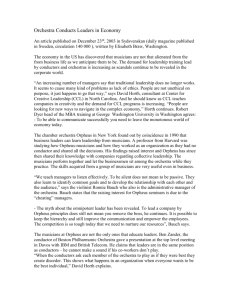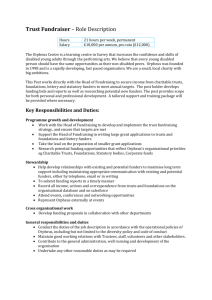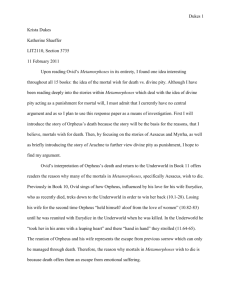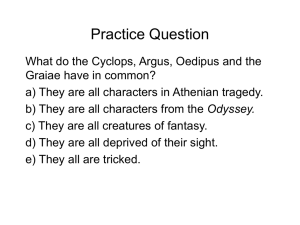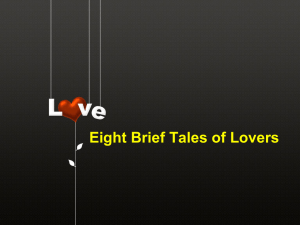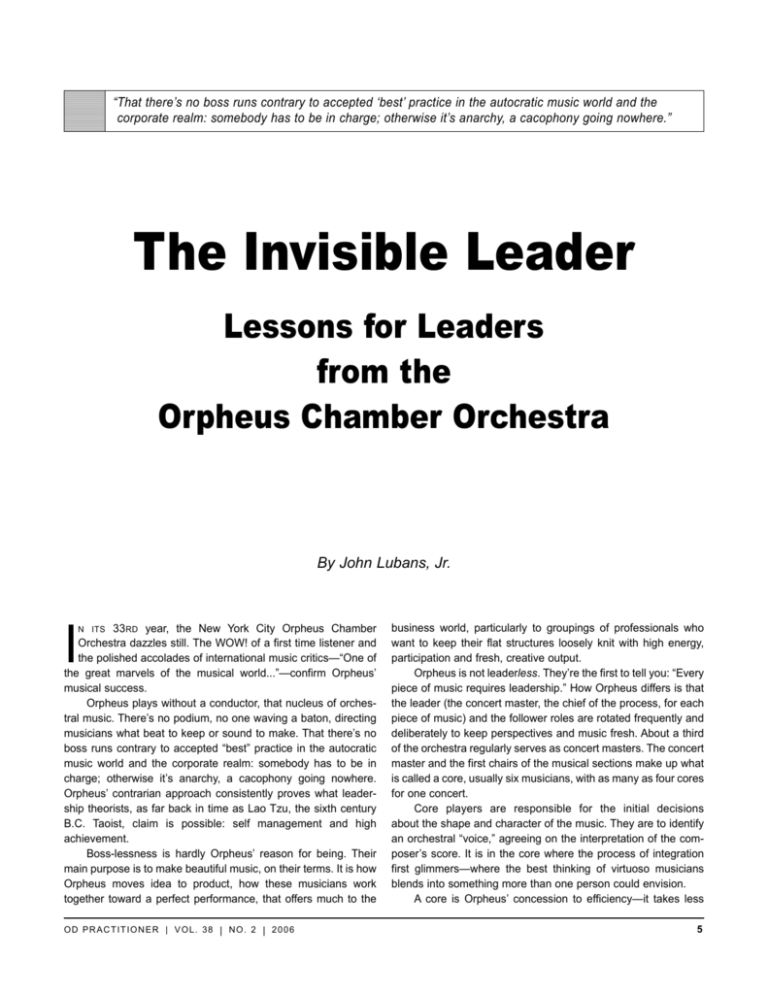
“That there’s no boss runs contrary to accepted ‘best’ practice in the autocratic music world and the
corporate realm: somebody has to be in charge; otherwise it’s anarchy, a cacophony going nowhere.”
The Invisible Leader
Lessons for Leaders
from the
Orpheus Chamber Orchestra
By John Lubans, Jr.
33RD year, the New York City Orpheus Chamber
Orchestra dazzles still. The WOW! of a first time listener and
the polished accolades of international music critics—“One of
the great marvels of the musical world...”—confirm Orpheus’
musical success.
Orpheus plays without a conductor, that nucleus of orchestral music. There’s no podium, no one waving a baton, directing
musicians what beat to keep or sound to make. That there’s no
boss runs contrary to accepted “best” practice in the autocratic
music world and the corporate realm: somebody has to be in
charge; otherwise it’s anarchy, a cacophony going nowhere.
Orpheus’ contrarian approach consistently proves what leadership theorists, as far back in time as Lao Tzu, the sixth century
B.C. Taoist, claim is possible: self management and high
achievement.
Boss-lessness is hardly Orpheus’ reason for being. Their
main purpose is to make beautiful music, on their terms. It is how
Orpheus moves idea to product, how these musicians work
together toward a perfect performance, that offers much to the
I
N ITS
OD PRACTITIONER | VOL. 38 | NO. 2 | 2006
business world, particularly to groupings of professionals who
want to keep their flat structures loosely knit with high energy,
participation and fresh, creative output.
Orpheus is not leaderless. They’re the first to tell you: “Every
piece of music requires leadership.” How Orpheus differs is that
the leader (the concert master, the chief of the process, for each
piece of music) and the follower roles are rotated frequently and
deliberately to keep perspectives and music fresh. About a third
of the orchestra regularly serves as concert masters. The concert
master and the first chairs of the musical sections make up what
is called a core, usually six musicians, with as many as four cores
for one concert.
Core players are responsible for the initial decisions
about the shape and character of the music. They are to identify
an orchestral “voice,” agreeing on the interpretation of the composer’s score. It is in the core where the process of integration
first glimmers—where the best thinking of virtuoso musicians
blends into something more than one person could envision.
A core is Orpheus’ concession to efficiency—it takes less
5
The Invisible Leader: Lessons for Leaders from the Orpheus Chamber Orchestra
REHEARSAL NORMS:
OVERHEARD AT REHEARSAL:
An Orpheus rehearsal is a collaboration of experts; disagreement happens within the bounds of mutual
respect. Two or more clashing views are explored and
merged, sometimes creating a superior third interpretation, other times settling on the best of the two ideas.
All ideas get their turn, even bad ones. Strict time limits
keep the discussion economical.
It’s OK to say “I don’t know”:
▪ “I can’t figure it out, can you play it for me?”
If you don’t agree, say so, and explain your thoughts:
▪ “It needs more glue.”
▪ “We should do this a bit slower, some people are
not getting it.”
▪ “Winds, answer our (strings) gesture. Rather than
just being on time, answer our gesture.”
Above all else, keep a sense of humor:
▪ After a long discussion without agreement the
player bemusedly tells the group: “I have to play
it.” The group responds: “We have to listen to it.”
(All laugh)
Keep asking until you really understand:
▪ “Is there any way to push up the tempo?” A wind
speaks up to the group, “Do you want an organ
sound or a chorale sound—what’s the style you
want?”
Criticize the music, not the player:
▪ “We’re trying to stay with you—points to ear—can’t
NOT PAINTING BY NUMBERS
There’s a tacit commitment in the core to speak truthfully, to
not settle for good enough. That commitment carries over to the
full rehearsal where musicians, besides those in a core, chime in
with precise commentary economically stated, with much fine
tuning of nuances and interpretations. (See sidebar.)
Following a composer’s score is not painting by the numbers. At best, the composer’s score is an incomplete road map—
numerous turnings and interpretations are possible—light, dark,
tense, relaxed, dreamy, moody, exhilarated. Simone Young, a
conductor, defines conducting, “I am an advocate for the composer—my place is to bring the will of the composer (in the most
honest way that I can interpret it) to the minds of the musicians
and on to the hearts of the audience.” Hence, conductors (and
Orpheus) are hailed as geniuses or reviled as “wannabes” based
on how well they interpret the composer’s intent.
Any musician who believes the interpretation is wanting can
stop the music to tell everyone what’s bugging them. Based on
my observing several rehearsals, about half of the players (different in each rehearsal) actively engage in refining the piece
being rehearsed. “Say it, sing it, play it” is the catchphrase for the
communications skill set essential in an Orpheus rehearsal. The
side bar illustrates the several prevailing norms—tacit understandings that give players permission to critique. All of these
norms apply to non-musical groups, e.g. “It’s OK to say I don’t
know.”
Orpheus’ high level of engagement, its aspiration to excellence exacts a personal cost. These musicians study the entire
score, not just their instrument’s segments. They listen to recordings of the entire piece and they practice individually most days.
For one player, gaining a 10% improvement in performance
means working 30 percent harder than in a conductor-led
rehearsal. Doing so takes sacrifice, and was, until recent years,
largely uncompensated. That sacrifice represents the necessary
involvement that leads to a better product. “At this level of participation, we own the company,” says an Orphean.
hear you.”
▪ “There’s too much of a ‘we’re in the forest’
DISPENSING WITH THE CONDUCTOR
(sound).”
▪ “Let it happen, don’t push it.”
time in sorting out and shaping the music than would the entire
orchestra. Prior to inventing the core, the full orchestra staged
marathon rehearsals far into the night that overburdened even
the most energetically democratic of the Orpheus troupe.
Were famed management theorist Mary Parker Follett living,
she would regard the core as a splendid example of what best
leadership is about, “Leader and followers are both following the
invisible leader—the common purpose.” This notion of leading
has “penetrated” the organization.
6
“You must hate conductors” is an assumption some listeners
make about Orpheus. One year, the Orpheus marketing flier featured a snapped baton—an icon of what this orchestra is not
about. Dispensing with the conductor, Orpheus confounds our
accepted ways of working, of following, of being led. How
Orpheus works questions the conventional definition of leader, to
envision and direct.
Yet, Orpheans will tell you: “We don’t hate conductors.”
What Orpheus does hate is abdicating personal responsibility.
These musicians want a say in their music. They want elbowroom, just like anyone else, to make the decisions that influence
their work. And, they want their expert voices to be heard. In fact,
Orpheus is an unintended training ground for conductors, with
OD PRACTITIONER | VOL. 38 | NO. 2 | 2006
two current players taking up the baton from time to time and
three emeriti conduct, one full time!
Further proof of Orpheus’ détente with the conducting kingdom is that the recently formed Orpheus Artistic Advisory Council features the maestro conductor, James Levine, of the Metropolitan Opera.
The contrast between a conductor led rehearsal and an
Orpheus rehearsal is immediate. Under the baton, communication is almost always one way. One cellist says that the ready
give and take at Orpheus is never seen in a large orchestra. You
simply, “cannot comment like (that) to a symphony conductor.”
He adds, “The large orchestra is built around the notion that the
conductor’s authority is absolute. If he/she were ever to accept
advice or a suggestion from a member of the orchestra, it would
have to be done in private …. Any other scenario would suggest
weakness ….”
A substitute viola player says the “difference between playing with Orpheus and traditional conductors is that you are fully
engaged, not just following the leader.” If two people have different ideas they try it both ways and then decide together how it
will be done in the end. “They really try it both ways without not
trying.” The honest discussion of an Orpheus rehearsal is
“riskier,” yet, for her, the viola player, all the “extra work and self
investment makes playing more fulfilling.”
“I learned more about conducting by watching you rehearse,
than I have in all my conducting classes.” That is what a Juilliard
School of Music conducting student had to say after sitting in on
an Orpheus rehearsal. While this student one day will be a conductor, he now better understands there is a process for and
value in soliciting ideas from the players—the people doing the
work. And while that may sound obvious to most managers, it is
a lesson worth restating and practicing.
THE CONDUCTOR MODEL
Not everyone agrees that the Orpheus model of music making is best. One critic prefers the conductor model: “A conductor
would make it better, but with a conductor it wouldn’t be
Orpheus.” Paradoxically stated, the critic seems to believe a
boss man would improve Orpheus’ sound. He is not alone in
what may be a genetic predisposition towards a pecking order, a
social Darwinism. Someone has to be in charge for things to
really work. For this same critic, Orpheus’ sound is not as refined
or precise as it could be because “of infinitesimal uncertainties
natural to pure democracies. Pinpoint agreement of pitch and
gesture is stretched to a kind of benign vagueness.”
And, some people just can’t trust the process—there has to
be a boss, and they are it! When the Teutonic chanteuse, Ute
Lemper, guested with Orpheus, “Ms. Lemper made sure no one
could miss any points, right down to the … orchestra, which she
kept conducting with her left arm.”
There are imperfections and limitations in the Orphean
model. At one rehearsal the timpanist never raised his head from
OD PRACTITIONER | VOL. 38 | NO. 2 | 2006
ORPHEUS TAKE-AWAYS FOR THE NON-MUSICAL BOSS
Take turns leading, take turns following.
Encourage independent and articulate critical thinking.
Manage self, disagree agreeably.
Listen with all your heart.
Be responsible toward the organization.
Demonstrate a philosophy of work that values followers
and leaders.
the soccer magazine he was reading and, similarly, one of the
horn players multi-tasked between the musical score and the
Daily News. More significantly, a former executive director told
me that at times Orpheus may choose to “not do things we don’t
like, like holding ourselves accountable to the highest standards
of musicianship or confronting players no longer performing well
enough.” For example, Orpheans still talk about the violinist who
turned into a tyrant whenever it was her turn as concert master.
Five or six years passed before she was finally confronted. To
everyone’s relief, she quit the organization
Of course, the hierarchy may not do much better in dealing
with those things we don’t like to do—it may, at times, do worse.
Orpheus recognizes that orchestras exceeding 40 or 50
musicians in size may be too complex for the Orpheus model: the
distances between seats among 120 players interrupt the
required intimacy and congest the sight lines.
So, while the Orpheus model will not fit all organizations or
situations, elements of Orpheus are relevant to most organizations. Their ideas may be most applicable in keeping leadership
fresh in organizations of the right size with an unchanging repertoire. Many nonprofits come to mind, including service agencies
and educational enterprises.
The Chairperson of the Orpheus Board of Directors, Connie
Steensma, testifies to Orpheus’ relevance to the business world.
She has been an avid fan, since 1987, of Orpheus. Initially, she
was drawn by the beauty of the music—“these are my rock
stars.” Then, in the early 90s, as the president of a consulting
firm, she was drawn to the ways in which Orpheus worked: the
sharing of leadership, the taking of individual responsibility, and
the literal movement of players to fit the musical sound. It
dawned on her that how Orpheus worked just might apply to the
business world. When faced with facilitating a merger of two corporate Information Technology departments, she applied several
Orpheus inspired ideas. She rotated the IT leadership and mixed
levels of leaders and followers to the maximum advantage.
Because of the Orpheus influence and, importantly, the “consummate professionalism of the IT staff involved”—and their
desire for success—the IT merger clicked.
7
The Invisible Leader: Lessons for Leaders from the Orpheus Chamber Orchestra
FOUNDER’S SYNDROME
All has not gone smoothly for Orpheus. Julian Fifer, the cellist-founder of Orpheus, left in 1999. Since then there have been
three executive leaders. In 2002, after a series of financial and
leadership crises, Orpheus was on the brink of dissolution—the
music just about died. The classic elements of the founder’s syndrome had sapped the players confidence and left some traumatized by
uncertainty and ambiguity.
Connie Steensma, in her first term
as chair of the Orpheus Board of Directors, guided Orpheus through the
refiner’s fire of that tumultuous 30th
year. Responding to the musicians’
pleas: “You have to save Orpheus,” she
applied her consulting knowledge, helping the musicians not just get past the
immediate crisis but to decide what they
wanted to be.
The orchestra regrouped and concluded it wanted to be a viable and continuing institution. While their music
lingers in the hearts of the audience
after each concert, Orpheus believes its way of working—the
how—is a large part of their legacy. According to several musicians, Orpheus now has “a view of the future… a common view.”
It is a shared vision that seeks to perpetuate Orpheus’ unique
music making and leadership.
An essential task, after their near-musical-death experience,
was to re-cast Orpheus’ administrative infrastructure to help the
organization achieve well-planned and managed development.
The musicians recalled how the dynamics changed not for the
best when the cellist founder stopped playing and became the
full time executive director. Nor did the two succeeding EDs play
in the orchestra. The next to last executive was seen by many
players, amid reports of shouting matches and bad feelings, as
more boss than colleague, someone who was imposing his will
on the business side and trespassing into musical decisionmaking.
The organization opted for a higher risk model, a return to its
roots, replacing the executive director position with a
player/leader akin to the managing partner idea in some law
firms. A long time Orpheus violinist was persuaded in 2002 to
lead the organization and to keep playing. To help him balance
the two roles, he negotiated for the business side of the organization to be as professional as the artistic. On the business side
sits a general director, entrusted with
much of the day-to-day operations. He,
the player/leader and three elected senior musician “coordinators” share in the
running of the organization with its
annual four million dollar budget.
Unpretentious and unassuming—
the player/leader dispensed with the
Executive Director title and converted
the former ED’s office into a meeting
room. He seems the perfect unboss
with his understated, thoughtful
approach; just what Orpheus needed.
Three years later, Orpheus is solvent
and spirits are high. New initiatives
include the Orpheus Institute at Juilliard, a platform for broadcasting the
Orpheus approach to music. And, there’s a fascinating collaboration with the Manhattan School of Music in which Orpheus
musicians coach the MSM student orchestra to play without a
conductor.
There are now various initiatives to assure Orpheus’ longterm stability and to lessen the financial stresses and anxieties to
which Orpheus (and most art groups in this country) often succumb. An endowment would help. Orpheans will tell you that in
the not too distant past, “Our “endowment” was Mr. ____’s (a
Board member) American Express card!” This angel would annually (and most generously) pluck the organization out of its red
ink. An endowment, of course, would steady Orpheus and lessen
the predictable administrative angst over a deficit.
Another plus is that the player/leader, the General Director,
the three Coordinators share willingly the load of running the
organization—a semi-permanent administrative version of an
Orpheus musical core.
The next to last executive
was seen by many players,
amid reports of shouting
matches and bad feelings,
as more boss than colleague,
someone who was imposing
his will on the business side
and trespassing into musical
decision making.
A UTHOR
JOHN LUBANS, Jr. MA writes about leading and following in organizations. Recent studies include the ramp
agent teams at Southwest Airlines, Zabar’s food store in
NYC and the Duke Women’s Basketball team. As a Visiting Professor, he teaches at the School of Library and
Information Sciences, North Carolina Central University.
He has a Master’s in Public Administration from the University of Houston and a Master of Arts in Library Science
from the University of Michigan. You may e-mail him at
Lubans1@aol.com.
8
LEGACY UNFOLDING.
It is Orpheus’ opening night at Carnegie Hall for the
2005/2006 season. Tonight they’re partnering with the legendary
pianist, Richard Goode, in performing pieces by Mozart and J. C.
Bach. As well, Orpheus has two solo pieces. One is Luigi Cherubini’s 1801 Overture to Faniska.
A 23-year-old newcomer to Orpheus is the concert master
for the Cherubini. Her musical ambition, harking back to the
mythical Orpheus, the orchestra’s namesake, is to “create even
just one magical moment for someone who is really listening.”
OD PRACTITIONER | VOL. 38 | NO. 2 | 2006
With an imperceptible gesture from her, the music starts quietly,
an awakening, a blending of gentle and strong, then, a gathering
of musical forces, stirring the audience. Heads lift and eyebrows
raise. Cherubini’s lyrical music soars to Carnegie’s heights, magically permeates the hall’s golden light, and touches the listener’s
heart. ■
REFERENCES
Burns, J. M. (1978). Leadership. New York: HarperCollins.
Follett, M. P. (1996). The essentials of leadership with commentary by Warren Bennis. P. Graham (Ed.) Prophet of management: A celebration of writings from the 1920s, 163-181.
Boston: Harvard Business School Press.
Kellerman, B. (2004). Bad leadership: What it is, how it happens,
and why it matters. Boston: Harvard Business School Press.
Kelley, R. E. (1988). In praise of followers. Harvard Business
Review, 66 (Nov.-Dec.), 142-48.
Kouzes, J. M., & Posner, B. Z. (2003). The leadership challenge
(3rd ed). San Francisco: Jossey-Bass.
Lubans, J. Jr. (2004). Leading from the middle. Library Administration & Management, 18: 205-207.
Marshall, P. (1992). Taoism and Buddhism. P. Marshall, Demanding the impossible: A history of anarchism 53-60. London:
HarperCollins.
Rehm, R. (1999). People in charge: Creating self managing
workplaces. Hawthorn House: 1 Lansdowne Lane, Stroud,
Gloucestershire, Great Britain: Hawthorn Press.
An invitation to write for the special
Positive Organization Development issue
of the ODPractitioner
The WINTER 2007 Issue will focus on research and practice methodologies that can be defined under the
general rubric of Positive Organization Development (POD) and Social Constructionism.
Articles need to examine positive approaches to OD associated with enabling, envisioning and generating
change in organizations through emphasizing theory and practices that represent the very best of the
human condition.
We invite you to examine your consultations and identify those in which you used theories and
methodologies that argue social reality is developed in processes of social action. For example, the research on
corporate social responsibility, diversity in the workplace, future search strategies, pro-social behavior and
stewardship, and positive applications of complexity theory are examples of generative dynamics in
OD practices. Benchmarking, incentive systems and directed changes in organization culture are additional
examples of positive applications.
Appreciative Inquiry is one such process that can bring about change from a positive, social constructionist
perspective, however this Issue of the ODPractitioner seeks articles that demonstrate other positive processes.
The final deadline to submit articles for this POD Issue of the OD Practitioner is October 15, 2006;
earlier submissions would be appreciated. Please submit articles to marilyn292@aol.com.
Don D. Bushnell, Faculty Emeritus
Fielding Graduate Institute
Guest Editor
Bushnell4@cox.net
OD PRACTITIONER | VOL. 38 | NO. 2 | 2006
Copyright © 2006 by the Organization Development Network, Inc. All rights reserved.
9


